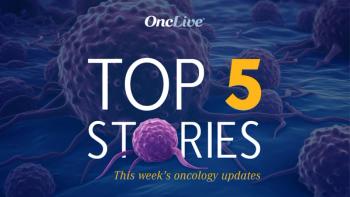
Physicians’ Experiences With CSF1 Inhibition in TSGCT
Transcript:
Shreyaskumar R. Patel, MD: As we were discussing earlier, pexidartinib is clearly the one CSF1 inhibitor that has shown true proof of principal activity. For the other CSF1 receptor inhibitors that we have had commercially available—such as imatinib, as you were alluding to earlier, which is a pretty potent inhibitor—the response rates tend to vary. They’re in the low teens to the 20%, 30% range. In all our personal experiences, true volumetric reduction of the soft tissue mass happens very rarely. The tumor may soften up a little bit, the symptoms may get a little better with imatinib, for example; but the true volumetric reduction that then reflects in some of the improvement in PROMIS [Patient Reported Outcome Measurement Information System] scores and stiffness rating and mobility of the patient in general seems to be far better with pexidartinib than we were used to seeing with the previous generation of CSF1 inhibitors.
Nilotinib is another agent that has been tested. It’s a weaker inhibitor of the CSF1 receptor compared [with] imatinib, as you outlined earlier, and just showed some anecdotal activity. In context of the CSF1 receptor inhibitors that we have clinical experience with, and we’ll come back to the ongoing clinical trials in a few minutes, this does seem to have encouraging efficacy data. The toxicity profile is generally manageable, but it is going to require some very close monitoring of the liver function tests.
The most important feature, however, is that since our orthopedic oncology colleagues are the ones who have followed these patients for a long time, they are the ones who are far more attached to the patients. Patients frequently would look at them as the source for guidance as to what they should really do. Drs Kim and Abraham are recommending no surgery. They’re sending patients to one of us. We’re offering this treatment, and the patient may well call the orthopedic surgeon’s office again. Let me bring our orthopedic surgeons back into the discussion to ask, what do you think about this drug and the data? Have you had experience? Share some of your thoughts about this drug in this disease.
John A. Abraham, MD: I did the certification for the REMS [Risk Evaluation Mitigation Strategy] program and all the required processes that were needed in order to be able to prescribe it, but I don’t plan to prescribe it. It was just to get a better sense of the disease and the drug and how patients respond.
My approach is, if I have a patient who I don’t think is surgically resectable or is multiply recurrent and I think it is a good idea to put them on the drug, I would then send them to a medical oncologist. I have gotten that phone call back from the patient asking, “What do you think? Do you think I should go on this drug?” My response is that it comes down to balancing the risks and benefits, which is basically that we do think that you’ll get symptomatic improvement from being on the drug but there are some risks. You need to know about what those risks are. I usually encourage the patients to have an extensive conversation with the medical oncologist about the risks of being on the drug, then view that in light of how bad their symptoms are.
Framing it in the conversation that we’ve had up to this point, it really has been a dramatic change in the landscape of how we treat TSGCT [tenosynovial giant cell tumors] to have pexidartinib approved. There is some excitement about it from both the medical oncology perspective and the orthopedic oncology perspective, because these are patients for whom we didn’t have anything else to offer. What we did have to offer—such as radiation, for instance—had a multitude of problems. I’ve had patients who have been on nilotinib and the other tyrosine kinase inhibitors, and just as you had mentioned, we may see some symptomatic improvement, but not a significant amount nor enough to make that the leading treatment for this condition.
I don’t necessarily encourage patients to take the drug, but I encourage patients to learn about it, learn about what the adverse effects are, and view that in terms of what their symptoms are. I let them know that I think it is potentially a good option for somebody in their situation because I’ve run out of things to do for them. Now that we have this ability to treat them, it’s something they should consider.
Shreyaskumar R. Patel, MD: Dr. Kim?
Tae Won B. Kim, MD: The patients do ask us quite a lot about what I think about the drug and the adverse effects. I think it behooves us to be very well aware of the adverse effect profile and the efficacy data from this drug. For patients [with diffuse TSGCT], I always incorporate the discussion of pexidartinib, at least in the discussion as a way of introducing the idea that we’ve got this treatment option that’s on the table. It may not necessarily be right now that it’s necessary, but at least if they are well educated on it, when I do send them to medical oncologist, they can have a more fruitful discussion regarding it. Their reaction is not, “Oh my god, it’s this new drug, I don’t know anything about it.”
Where I see the discussion starting to occur with this drug is, where in the timeline do you use the drug? Is surgery necessary with the drug? Is it not? Is it a drug alone? The patients who have been on pexidartinib symptomatically are dramatically better. They are functioning. The patients who have been on the trial were looking at the trial and saying, “Oh my gosh, the trial is ending soon.” They had genuine fear that they weren’t going to be able to get the drug. Clearly it makes a huge difference in people’s lives. The question will be if you use drug, where does surgery play into it? Where does that treatment paradigm fit?
Shreyaskumar R. Patel, MD: In many ways everybody on the panel also treats giant cell tumors of bone. There is an interesting parallel here between both these tumor types where there are drugs that do work, they do induce improvement in symptoms, but the unanswered questions as of yet—that hopefully we will be able to [answer] with a little extra passage of time—is how long they continue the drug and what happens if they stop the drug. As you mentioned, is there some consolidative surgical procedure that is necessary, or is the durability of the benefit long enough such that you don’t need to go back to the drug. There are plenty of unanswered questions that the trial hadn’t addressed, but I think the phase 4 post-marketing experience will clearly help us address this over a longer period of time. A fair statement, as you all summarized, is that for the patient for whom surgery is not a good idea—with diffuse or symptomatic disease, who is suffering—we do have an option.
Transcript Edited for Clarity

























































































